— 25 years after the end of Gulf War —
“Meeting of supreme Islamic leaders” held to prevent escalation of the Gulf War into religious war
Ikuzo Kobayashi, President of Salaam Association
From the Winter Issue of the electronic Salaam Quarterly Bulletin, No.20, November 2016
A meeting of supreme Islamic leaders was held in Cairo, Egypt on October 21, 1990. It took place in the height of the Gulf crisis triggered by Iraqi military’s occupation of Kuwait. The meeting was sponsored by the Rev. Sun Myung Moon, the founder of the Holy Spirit Association for the Unification of World Christianity (currently the International Family Federation for World Peace). The Rev. Moon sent a message to the meeting with strong expectation for religious leaders, especially Islamic religious leaders to fulfill their responsibility to avert transformation of the Gulf crisis into religious war.
1. Iraqi invasion of Kuwait

Iraqi Army T-72M main battle tanks. The T-72M tank was a common Iraqi battle tank used in the Gulf War.
At 2 am on August 2nd 1990, more than 300 tanks and 100,000 Iraqi troops crossed the border with Kuwait. The Kuwaiti army resisted the invasion for 8 hours, but the Iraqi troops controlled the entire Kuwait by the end of the day. Kuwait’s Emir, Jaber Al-Ahmad Al-Jaber Al-Sabah fled from the Dasman Palace and established a government in exile in Saudi Arabian resort Taif. The United Nations Security Council held an emergency session and adopted a resolution on the same day which condemned the Iraqi invasion of Kuwait strongly and demanded immediate and unconditional withdrawal of the Iraqi troops (the UN Security Council resolution 660).
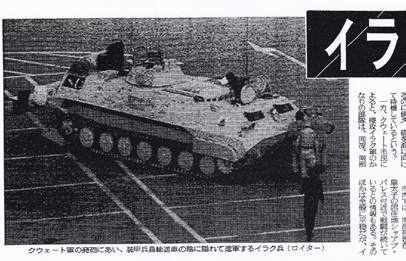
Iraqi soldiers advancing while hiding behind an armored personal carrier to defend against Kuwaiti bombardment. (August 3, 1990 evening issue of the Yomiuri Shimbun)
As there was an indication that Iraq may invade even Saudi Arabia, the United States, the Great Britain, France and the Soviet Union formed an encirclement line to contain the Iraqi troops on August 6. 4000 United States troops including airborne troops with fighter jets were dispatched on the 7th and they arrived in the base in Dharan, Saudi Arabia by the 8th. They joined with troops dispatched from other countries and formed a multi-national force.
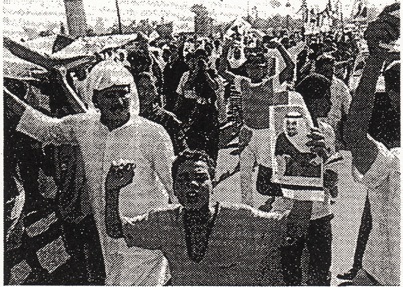
Kuwaiti citizens in Egypt marching in demonstration against Iraqi invasion of their country in Cairo on August 3. (August 4, 1990 morning issue of the Yomiuri Shimbun)
The United Nations Security Council expected the Arab League to take an initiative to resolve the crisis because “the Iraqi invasion of Kuwait was considered to be a conflict within the Arab region.” In response, Egyptian President Mubarak demanded immediate withdrawal of the Iraqi troops and called for “resolution by peacefultalks” on the condition of restoration of Emir Al-Jaber to power. However, Iraqi President Saddam Hussein declared annexation of Kuwait as “19th province of Iraq” on August 9, which precluded the resolution by peaceful talks.
2. Offense and defense within the Arab League during the Gulf Crisis
The Arab League was established in March, 1945 as a regional organization for cooperation among Arab countries in the height of Arab nationalism movement. Under the proposal from Egyptian President Gamal Abdel Nasser,
it started holding the Arab Summit in 1963.
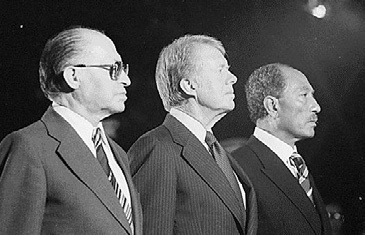
The Camp David Accords were signed by Egyptian President Anwar El Sadat (right) and Israeli Prime Minister Menachem Begin(left) at the mediation of U.S. President Carter on 17 September 1978, following twelve days of secret negotiations at Camp David. 3 leaders at Marine Corps Parade on 7 September,1978. From left to right: Menachem Begin, Jimmy Carter and Anwar Sadat (White House Photographs Collection)
The Camp David Accords were achieved in September, 1978 under which Egyptian President Anwar El Sadat and Israeli Prime Minister Menachem Begin agreed bilateral ceasefire and mutual recognition. Egypt, the leader of the Arab League thus virtually undermined the common policy of the League toward Israel based on the policy of “no peace, no negotiation and no recognition.” As the result, Egypt was expelledfrom the Arab League in 1979 and the Arab League headquarters were relocated to Tunis, Tunisia.
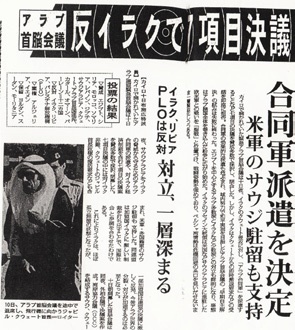
At an Arab summit in Cairo on Aug. 10, a dozen Arab leaders adopted a resolution condemning the invasion, calling for Iraq’s unconditional withdrawal and agreeing to send an all-Arab military force to Saudi Arabia. Iraq’s allies dissented in that vote. (August 11, 1990 evening issue of the Mainichi Shimbun)
In 1990, Egypt rejoined the Arab League and the League headquarters returned to Cairo. However, serious internal divisions remained in the League.
In response to the Iraqi statement of “annexation of Kuwait” on August 9, the United Nations Security Council unanimously adopted a resolution to make the annexation invalid.
The emergency session of the Arab Summit was held on August 10 and adopted by majority support 7 action items including dispatch of the Joint Arab Force, economic sanctions against Iraq, restoration of the administration led by Kuwaiti Emir Al-Jaber, stationing of the United States and multinational forces in Saudi Arabia. Twelve countries including Egypt, Saudi Arabia, Kuwait, the United Arab Emirates, Qatar, Oman, Bahrain, Syria, Morocco, Somalia, Lebanon and Djibouti supported them. Iraq, Libya and PLO were against them. Jordan, the Sudan and Mauritania declined to take a position and Algeria, Yemen abstained. Tunisia did not attend the session.
It was reported that angry words were exchangedand chaos prevailed in the session. Nevertheless, it was significant that the Arab Summit session was held to seek voluntary resolution of the crisis within the Arab region. The fact that the 7 action items were adopted by majority votes meant that the Arab countries officially went along with the United Nations Security Council resolution. The United States President Bush immediately issued a statement supporting the Arab Summit resolution.
On the same day, Kuwaiti Emir Al-Jaber sent a letter to President Bush requesting the United States to implement the sanctions against Iraq. The United States used this request as the “legal base for immediate and effective implementation of economic sanctions”. President Bush stated that he had made a decision to implement all necessary measures and initiate naval blockade against Iraq.
On the 10th, 3000 Egyptian troops arrived in Saudi Arabia as the first group of the Joint Arab Force.
3. True intention of Iraqi regime and popularity of Saddam Hussein
Again a backdrop of emergence of Islamic fundamentalism, Islamic revolution led by a radical Islamist was carried out in Iran in 1979. Success of the Iranian revolution stimulated Islamic fundamentalists within the Arab countries and caused their further radicalization.
Neighboring Arab countries with substantial population of Shiites considered “export of Islamic Republic revolution” as a potential threat. Formation of the Gulf Cooperation Council (GCC) in May, 1981 was to cope with such threat.
The country which faced such threat most acutely was Iraq. Iraq shares border with Iran and 60% of its population are Shiites. Sunnis which formed foundation of the regime amounted to 20% of the entire population and remaining 20% strongly identified themselves with the Kurds and were critical toward the regime.
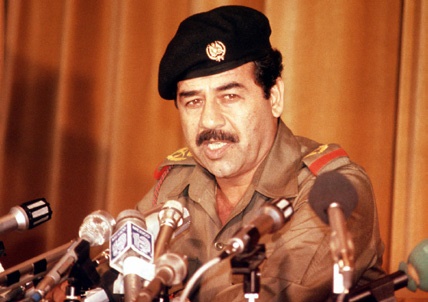
Saddam Hussein in 1980 when he started the Iran-Iraq War(IB ZINE)
Iraq’s Hussein regime was ruled by one party, the Baath Party. Hussein’s relatives and those from Tikrit, Hussein’s hometown formed the inner core of its military, police and political party. Iraq was controlled by the secret police. Because of this, the regime was not supported by the Sunni fundamentalists.
Saddam Hussein’s true intention in starting the Iran-Iraq war was to solidify his fragile foundation of the regime. The “potential threat of export of the Islamic revolution” was a convenient excuse. Iraq could initiate a war under the pretext that it was for “Gulf countries exposed to the common threat.”
The posture of Saddam Hussein as the “hero of the Sunni Arabs who stood against Shiite Iranians” attracted support from the Arab League and Saddam gained popularlity among masses in the Sunni Arab countries. The Iraqi invasion of Kuwait took place only two years after the end of the Iran-Iraq war, and Saddam’s popularity was still strong among masses in the Arab countries.
4. Strategy of Saddam cornered: “Human shield” and “Israel linkage”
On August 17, Iraq under seize by the multinational force and economic blockade declared the “hostage-taking operation” to come out of the predicament. On August 24, Iraqi troops encircled foreign embassies in Kuwait and issued a notice on termination of diplomatic privilege. The United Nations Security Council overwhelmingly adopted the resolution to allow ‘limited use of force to secure effectiveness of sanctions” on August 25.
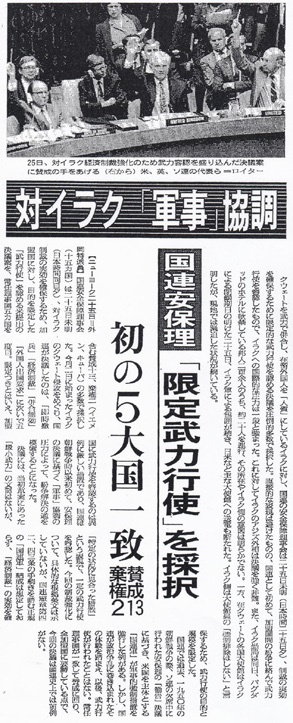
The United Nations Security Council adopted by overwhelming majority a resolution allowing limited use of force against Iraq which annexed Kuwait by force and held foreigners as hostages. (August 26, 1990 issue of the Asahi Shimbun)
The hostage-taking operation is a strategy to use hostages placed in the Iraqi buildings targeted by the multinational force as a “human shield” to deter the offensive. Because of this strategy, the offense and defense were prolonged.
Furthermore, Saddam Hussein demanded withdrawal of foreign troops from the Arab region as the condition for withdrawal of Iraqi troops from Kuwait. More specifically, he demanded the troop withdrawal from the areas occupied by Israel since the Third Middle East War in 1967 including the West Bank of the Jordan River, Gaza and the Golan Heights. In other words, he launched the so-called “Israel linkage” strategy, saying “If the United Nations demands Iraqi troop withdrawal from Kuwait, the UN should likewise demand Israeli troop withdrawal from the occupied territories of Palestine.” He then appealed to the masses in Palestine and Arab areas for “Arab unity against Western countries and Zionists” and “jihad” against the infidels.
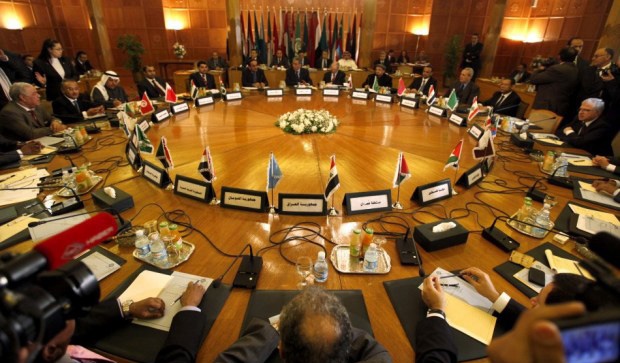
The assembly at the headquarters of Arab League, Cairo, Egypt.
The United States President Bush characterized this appeal as “Iraq’s new scheme to avoid isolation from the international community.” He issued a statement that “the Gulf Crisis and the Israeli-Palestinian conflict should be separated,” and rejected the condition of troop withdrawal from Hussein.
In the Arab foreign ministers meeting in Tunis on October 20, the foreign ministers challenged the Iraqi demand by issuing a statement that they “confirmed that linking the Gulf Crisis to the Palestinian issue was wrong.”
5. Emir Al-Jaber’s speech at the United Nations and the National Congress in Jedda
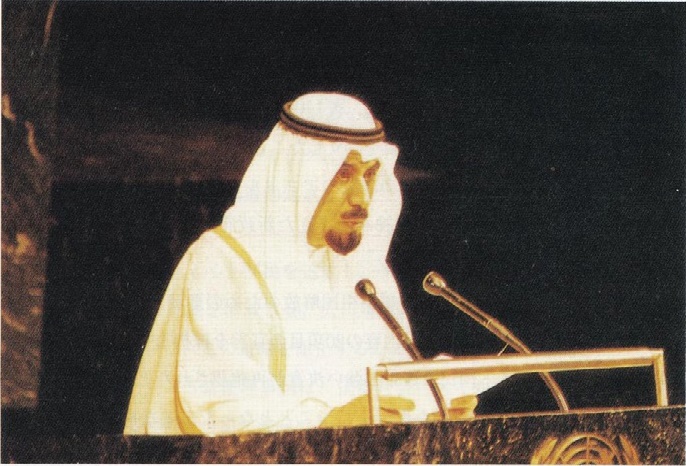
The Emir of Kuwait, Sheik Jaber Al-Ahmad Al-Sabah, came before the United Nations General Assembly to plead for his country’s liberation from Iraq, urging the organization to stand by the sanctions it has imposed on Iraq(Sep 27, 1990) = page67,”Kuwait”published by Kuwaiti embassy in Japan, Feb 28, 2000)
On September 27, Emir Al-Jaber delivered a speech at the United Nations General Assembly in New York. He express his deep gratitude for the international community’s support for Kuwait, and appealed for liberation of Kuwait. He stated, “An independent, sovereign nation and a UN member country is about to be occupied, annexed and eliminated by force. The destiny of a country is in the hands of the United Nations.”
Emir Al-Jaber held the National Congress in Jedda from October 13 to 15. More than 1000 people including citizens of Kuwait escaping to and staying in Saudi Arabia, or evacuated in Bahrain, Egypt, Syria and Jordan gathered at the Congress. Emir Jarber, Prince Saad and participants representing many fields and walks of life exalted Emir Jaber as the chief elected by the people and united with him. They confirmed their determination to unite to fight a holy war to liberate their homeland.
6. Dangerous traps of the “Israel-linkage” strategy
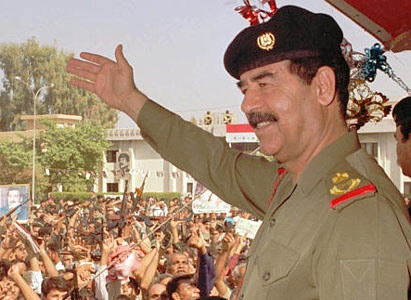
On August 12, 1990, Iraqi president, Saddam Hussein, stated that Israel’s withdrawal from the occupied territories was a necessary precondition for Iraq’s evacuation of Kuwait.
Saddam Hussein has long been promoting the “double standard theory.” The double standard theory has spread a perception that the Western countries are lenient toward Israel and strict toward Arab countries in the Middle East region. Saddam utilized this double standard theory as a strategy against the United Nations resolution. Thus the Israel-linkage strategy was created.
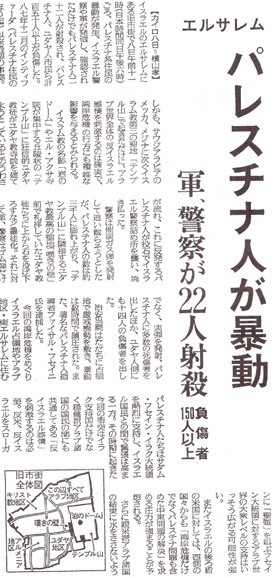
On October 8, a Palestinian riot in the old city of Jerusalem (Oct 9, 1990 morning issue of Yomiuri Shimbun)
Although the issue of Israel-occupied territories Saddam pointed out is something which should be resolved, it is very different issue in term of the time, background and region. It is totally separate issue which has nothing to do with the issue of invasion and annexation of Kuwait carried out by Saddam Hussein. Nevertheless, he continued arguing strongly that “If the United Nations demands Iraqi troop withdrawal from Kuwait, the UN should likewise demand Israeli troop withdrawal from the occupied territories of Palestine.” At that time, tension between Israel and Palestine continued in the West Bank of the Jordan River and there was a high risk that an unpredictable conflict may break out in the holy land of Judaism, Christianity and Islam. Saddam Hussein apparently aimed at inducing an unpredictable conflict in Jerusalem which can cause riots and PLO uprising. If this occurs, the Gulf War may have escalated into a religious war between Judaism/Christianity and Islam.
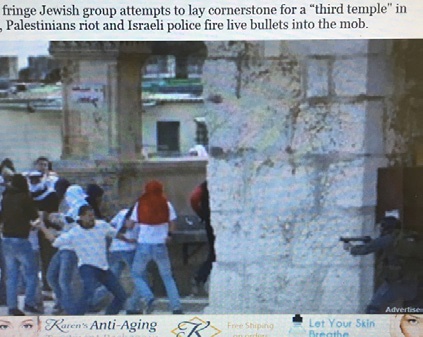
October 8, 1990: In the bloodiest day of the intifada, Israeli police respond to a Palestinian demonstration by killing 20 people and wounding many others. Called the incident of the Temple Mount, the Palestinians were protesting plans by an Israeli fringe
group to construct a Jewish temple on the site of Jerusalem’s holiest Islamic shrines.
(screenshot:Jerusalem Post website)
Saddam Hussein criticized the multinational force deployed in Saudi Arabia including Mecca, Islamic holy land, and claimed that “the holy land Mecca fell in the hands of the United States and Zionists.” He also called for a “holy war to regain the holy land” in Jerusalem as if to remind people about the Crusade war and appealed for the Arab unity. His series of claims indicate that the Israel-linkage strategy was extremely dangerous traps.
He continued to hope for such development to the end. He ordered launching of 38 Scud missiles against Israel during the Gulf War which started on January 17, 1991.
7. Message of the Rev. Sun Myung Moon during the meeting of supreme Islamic leaders
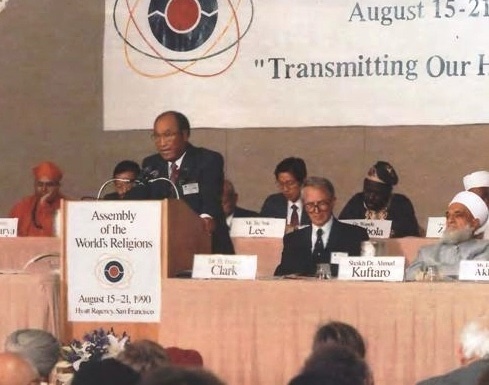
Rev. Sun Myung Moon delivers the Founder’s Address at the Second Assembly of the World’s Religions on August 18, 1990, San Francisco.
As the risk of the military clash between the Iraqi troops occupying Kuwait and the multinational force increased, the danger of unpredictable conflict also increased in the unstable Palestine area as Saddam Hussein aimed at through his Israel-linkage strategy. In the midst of this crisis, the Rev. Sun Myung Moon held a meeting of supreme Islamic leaders in Cairo Egypt on October 21, 1990 as part of the World Religious Assembly. 18 Islamic leaders from various countries including Syria’s Grand Mufti, Ahmed Kuftaro attended the meeting.
As the sponsor of the meeting, the Rev. Sun Myung Moon who is a world-class religious leader from South Korea, sent a message.
His message focused on the Gulf Crisis and strongly reminded Islamic religious leaders’ responsibility to prevent escalation of the Gulf Crisis into a religious war.
In sum, the message advocated that (1) the root of peace is God and only those who follow God’s Will can achieve peace; On the contrary, Satan is trying to cause religious and racial wars as the last offensive to bring doom to the mankind; (2) The reason why the Middle East is most tension-filled area on the earth is that the region is the battlefield of war between God and Satan; (3) All religious people have a mission to reject the evil force which likes racial and religious conflicts and promote God’s Will to seek the world peace; (4) Just as Jesus and Muhammad gained victory through self-sacrifice and tribulation, the unchanging justice of God is to prioritize the interest of the entire world over the interest of one nation; and (5) Religious leaders have a greatest responsibility for peace in the present circumstance in which a religious war may break out.
8. Basic views of Islamic religious leaders

The Quran
Although the materials on the contents of the meeting of supreme Islamic leaders is not available, I am going to introduce the basic views of Islamic religious leaders, citing the Washington Times editorial titled “Saddam and Islam” which introduced views of Islamic leaders during the Gulf War. (The Washington Times editorial “Saddam and Islam” dated January 24, 1991)
“If two parties among the Believers fall into a quarrel, make ye peace between them: but if one of them transgresses beyond bounds against the other, then fight ye (all) against the one that transgresses until it complies with the command of Allah; but if it complies, then make peace between them with justice, and be fair: for Allah loves those who are fair (and just). (Quran 049.009)
It is written that the most authoritative Islamic religious figure declared that “Iraq’s invasion of Kuwait” violates principles of the Quran.

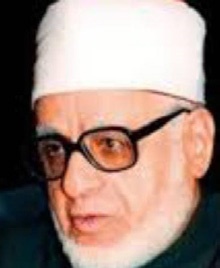
Al-Azhar University(left) in Cairo is the oldest university in the world, established in 970. As “Sunni Islam”s most prestigious university, it has the authority of the head temple as well. Photo: Grand Imam of al-Azhar at that time, Gad al-Haq
Gad al-Haq, then president of Al-Azhar University and Grand Imam stated that “both the Arab world and non-Arab world, Muslims and non-Muslims have made efforts to make the oppressor (Saddam Hussein) stop invasion. Because the oppressor rejected such efforts, the war is justified.” He further showed his view about the reason to support the war against Saddam Hussein, saying, “The true enemy of Islam is not the West but unbelievers.” He said, “The Quran distinguishes fighting Christians and Muslims who believe the same God from fighting infidels who believe neither God nor the Day of the Last Judgment.” He pointed out that the materialism is at the root of Saddam Hussein’s socialistic dictatorship which he rejects.
9. The UN Security Council resolution which allows use of force against Iraq with withdrawal deadline of January 15

On November 29, the United Nations Security Council adopted the resolution
678 which virtually allowed use of force and all necessary measures to urge Iraq to
withdraw from Kuwait with final deadline of January 15, 1991.(November 30, 1990
evening issue of the Chunichi Shimbun)
On November 29, the United Nations Security Council adopted the resolution 678 which virtually allowed use of force to by granting the authority to employ all necessary measures against Iraq to force Iraq to withdraw from Kuwait with final deadline of January 15, 1991. The vote was by the majority support for the resolution. 12 member countries supported the resolution, 2 opposed (Yemen and Cuba) and one abstained (China).
Hussein insisted on the battle and did not change his confrontational posture. Although a direct dialogue between President Bush and President Hussein was agreed subsequently, disagreement over the agenda between the United States and Iraq which advocated Israel-linkage was too big. Thus the early realization of the dialogue was not likely. In response to Iraqi announcement about release of all hostages, President Bush stated “This development does not change my view that Iraq needs to comply with the UN resolution 100% unconditionally,” and emphasized his posture to maintain his demand of immediate, unconditional and total withdrawal of the Iraqi troops. The United Nations postponed the discussions on Palestine.
The Gulf Cooperation Council (GCC) held a summit in Doha on December 26 and adopted the Doha Declaration which demands unconditional withdrawal of the Iraqi troops from Kuwait and restoration of Kuwaiti official government. On January 6, foreign ministers from Saudi Arabia, Egypt and Syria issued a communique which states “Iraq’s efforts to emphasize the cause of Palestine to justify annexation of Kuwait by force cannot be recognized. Iraq which continues adventuristic policy is not qualified to discuss resolution of the Middle East problems or security issues.
Negotiations were held to avert the war until the last minute, but Iraq ran out of time to withdraw before the deadline. The United Nations’ mediation was terminated. The United States gave up on the diplomatic efforts and indicated early use of force.
10. The Gulf War, Operation “Desert Storm”
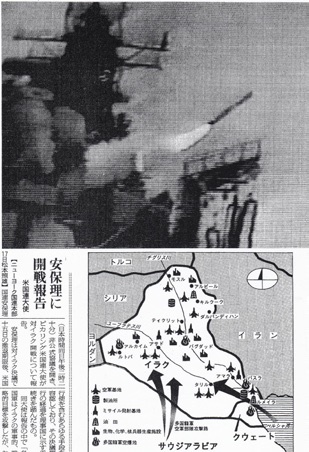
Cruise missile Tomahawk (January 18, 1991 morning issue of the Mainichi Shimbun)
680 thousand troops of the multinational force and 540 thousand troops of Iraq. Under the command of the US Commander Schwarzkopf and Saudi Defense Minister Sultan Aziz, the Operation Desert Storm of the Gulf War began at 2 am on January 17, 1991. The United States military started bombing of Iraq with Tomahawk missiles and F-15 fighters. It was 18 hours after the deadline for withdrawal. The multinational force gained air superiority against Iraq on the same day by aerial bombardment utilizing high technology. On the other hand, although the multinational force appeared to have destroyed almost all missile sites along the border with Jordan, Iraq launched missile attacks against Israel on January 18 and 19. As the world watched Israel’s reaction, Israel restrained itself and did not retaliate against Iraq. Internal debates between those who support retaliation and those who do not continued on, but Israel abstained from retaliation to the end.
At 4 am on February 24, the multinational force sent troops from both the ground and the sea and the ground war started. The multinational force units which entered Kuwait first included 4000 Kuwaiti soldiers who went through the military trainings in Saudi Arabia. The Iraqi troops fled from Kuwait after they had destroyed and set fire more than 700 oil wells. They abducted Kuwaiti citizens as prisoners of war.
In lopsided defeat, the state-owned Iraqi Broadcasting conveyed the order to withdraw Iraqi troops on February 26. This was de facto liberation of Kuwait. It also referred to the linkage between the Palestine issue and the Gulf Crisis issue that had been advocated, and stated the position not to link them directly. Thus, Iraq was virtually defeated 40 days after the start of the war.
Tightrope diplomacy of Turkey strengthening relation with Russia
–Invasion in northern Syria to sweep IS–
Takafumi Honda, Journalist
Turkey is on the offensive in the extremist organization “Islamic State” (IS) sweeping operations in Iraq and Syria. While it has been seen as a warning against the Syrian Kurdish forces and Shiite forces of Iraq, improved relations with Russia was likely to encourage the military intervention in Syria. On the other hand, close relations with Russia has dropped subtle shadow also to relations with the United States.
Turkey fixes diplomatic relations with Russia
Turkey repaired relationship with Russia June this year which deteriorated after the Russian military aircraft was shot down by Turkish military in November last year. Relationship with Israel was also restored in the same month as foreign policy was shifted. Turkey had severed the relation with Israel after the Gaza aid ship of Turkey was raided by the Israeli forces and 10 Turks died in 2010.
Conversion of diplomacy may implemented partly because economic pressure from Russian sanctions, but Turkey should have had a speculation that it wants to grasp the clues of intervention in northern Syria where Kurds is extending its force by way of approaching to Russia.
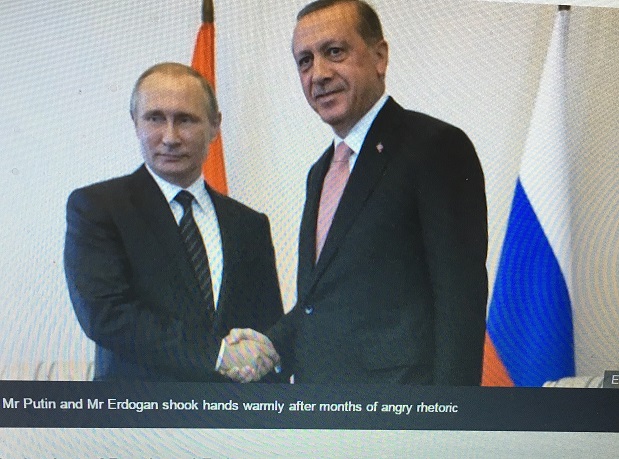
Putin mends broken relations with Turkey’s Erdogan, 9 August 2016(BBC website)
Turkey’s Erdogan visited Russia and met with President Vladimir Putin in Saint Petersburg August 9. The first visit to Russia after its military aircraft was shot down gave an impression of improving relations between the two countries.
In July coup attempt occurred in Turkey, more than 200 people were killed. Economic loss is said to be 100 billion US dollars, and it suffered political, economic big blow. The United States expressed concern about the forceful crackdown of the Erdogan government after the coup attempt, and relations of both countries has deteriorated. On the other hand, President Vladimir Putin praised the response of president Erdogan, saying to support a “democracy of Turkey.”
Russia which condemned Turkey as “an accomplice of terrorists” and has applied economic sanctions to Turkey after Russian military aircraft was shot down, made a 180-degree turn in attitude toward Turkey.
Improving relations with Iran is diplomatic tactics over sweeping IS
On the other hand, Turkey is also improving relations with Iran.
Turkey is wary that the Shiite regime which has received the support of the Shiite state of Iran is increasingly dominant in Iraq. Approaching to Iran as well as Russia could be also seen as a warn against the United States and the European countries. However, as Turkey has conflict of interests over IS sweeping with Russia and Iran, approaching to both countries should be seen as a tactical relationship-building for now.
Iran is intervening in the Syria civil war to support the Assad regime. Better relationship of Turkey with Russia and Iran will certainly affect Syria civil war. Turkey has clarified an attitude of anti-Assad regime and has allowed the US military to use Incirlik air base. But, there is a possibility that Turkey gave up on Western equivocal in response to the Syria civil war.
Turkish troops, the purpose of the Syrian invasion
It is Kurdish forces in Syria that has become the major factor.
Kurdish forces has been active in the IS sweeping since 2014. US cannot send ground forces, largely relying on the Kurdish forces in the strategy against IS.

The YPG female soldiers. The Syrian Democratic Forces(SDF)was formed on October 12, 2015,with the People’s Protection Units (YPG) as the main force.
They made a great victory in the offense and defense to IS over Ain Arab in northern Syria from 2014 through 15 years, obtaining trust of US and receiving the support of the US military.
In August 2016, Syrian Democratic Forces (SDF) mainly consisting of Kurdish forces in Syria conquered Manbij, a northern strategic point which had been under IS domination. This has stimulated Turkey.
Manbij is close to the Turkish border and on the west bank of the Euphrates. There is a Kurdish district on the east bank and there is Jarablus dominated by IS to the north.
Turkish army invaded Syria August 24 to recapture Jarablus in cooperation with Free Syrian Army, Syrian dissident armed organization. It was a full-fledged invasion in which more than 10 tanks was introduced. Turkey said its purpose was to expel IS and to ensure the rule of dissidents. But, it is said that its true purpose was to keep this land before SDF increasing the momentum in suppression of Manbij will expand the force up to Jarablus. As there is a Kurdish-controlled areas also to the west of Manbij, Turkey wanted to keep both of east and west Kurdish districts from connected each other.
Defense Minister Fikri Isik of Turkey also required the Kurdish forces to return to the east bank of the Euphrates, poising not to hesitate to use forces.
Domestic affairs of Turkey facing the Kurdish issue
Turkey has severely fought with Kurdistan Workers’ Party (PKK), a domestic Kurdish organization from 1980s, regarding PKK as a terrorist organization. More than 40,000 were dead in the conflict so far.
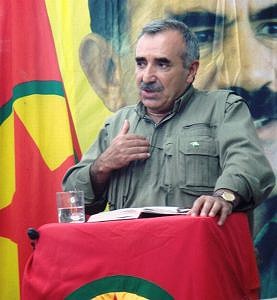
Murat Karayilan is the acting commander of the Turkey Kurdistan Workers’ Party (Partiya Karkeren Kurdistan – PKK) Photo: HPG
The Turkish government has been equated Kurdish organizations such as SDF in Syria with PKK and has an attitude that it will not absolutely allow Kurdish organizations such as the SDF to expand the force in along the Syrian border.
President Erdogan clarified his intention to sweep the Syrian Kurdish organizations such as Democratic Union Party (PYD) and its military wing, People’s Protection Unit (YPG) immediately after the Syrian invasion.
Russian President Vladimir Putin who deepens its relationship with Turkey met president Erdogan in Istanbul September 10 to appeal their good relationship. On Syria, they agreed to need to transport relief supplies to northern part of Aleppo which Assad regime forces and Russian forces are bombing. In addition the two countries signed an agreement on construction of the pipeline “Turkish stream” to export Russian natural gas to Europe via Turkey in the same day. The plan had been frozen in response to an incident in which a Russian military aircraft was shot down.
Speculation of Turkey seeking to be included in the recapture plan of Mosul, the largest base of IS
In addition, Turkish government is seeking to participate in the Mosul recapture strategy.

Peshmerga soldier with his modified M16, 31 December 2014 (Creative Commons/Claus Weinberg) HPG
Turkish troops have been stationed in northern Iraq to train Kurdish security forces to fight IS. However, Iraq claims that Turkey is infringing on the sovereignty and is seeking withdrawal of the troops.
Although the recapture plan of Mosul that IS dominates is conducted mainly by US-led coalition, Turkey is likely to aim to maintain a certain amount of influence in the northern Iraq by participating the recapture plan.
Intervention of Turkey to Iraq is also to check growing power of Shia. Therefore, cooperation with strong Kurdish militia Peshmerga is indispensable.
Turkey, while facing harsh domestic and Syrian Kurdish forces, is cooperating with the Kurdish forces that have autonomous region in Iraq. On the other hand, close relationship with Russia is dropping a subtle shadow on relations with US and European countries over Syria civil war. Turkish tightrope diplomacy continues.
More articles available in the electronic “Salaam Quarterly Bulletin”, No.20, November 2016.
